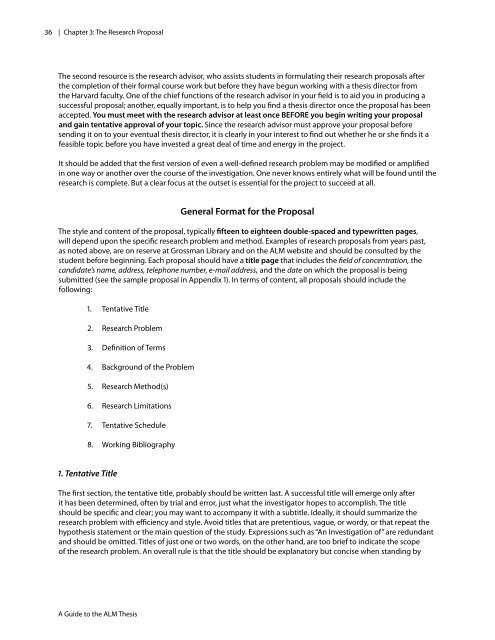A Guide to the ALM Thesis - iSites - Harvard University
A Guide to the ALM Thesis - iSites - Harvard University
A Guide to the ALM Thesis - iSites - Harvard University
Create successful ePaper yourself
Turn your PDF publications into a flip-book with our unique Google optimized e-Paper software.
36<br />
| Chapter 3: The Research Proposal<br />
The second resource is <strong>the</strong> research advisor, who assists students in formulating <strong>the</strong>ir research proposals after<br />
<strong>the</strong> completion of <strong>the</strong>ir formal course work but before <strong>the</strong>y have begun working with a <strong>the</strong>sis direc<strong>to</strong>r from<br />
<strong>the</strong> <strong>Harvard</strong> faculty. One of <strong>the</strong> chief functions of <strong>the</strong> research advisor in your field is <strong>to</strong> aid you in producing a<br />
successful proposal; ano<strong>the</strong>r, equally important, is <strong>to</strong> help you find a <strong>the</strong>sis direc<strong>to</strong>r once <strong>the</strong> proposal has been<br />
accepted. You must meet with <strong>the</strong> research advisor at least once BEFORE you begin writing your proposal<br />
and gain tentative approval of your <strong>to</strong>pic. Since <strong>the</strong> research advisor must approve your proposal before<br />
sending it on <strong>to</strong> your eventual <strong>the</strong>sis direc<strong>to</strong>r, it is clearly in your interest <strong>to</strong> find out whe<strong>the</strong>r he or she finds it a<br />
feasible <strong>to</strong>pic before you have invested a great deal of time and energy in <strong>the</strong> project.<br />
It should be added that <strong>the</strong> first version of even a well-defined research problem may be modified or amplified<br />
in one way or ano<strong>the</strong>r over <strong>the</strong> course of <strong>the</strong> investigation. One never knows entirely what will be found until <strong>the</strong><br />
research is complete. But a clear focus at <strong>the</strong> outset is essential for <strong>the</strong> project <strong>to</strong> succeed at all.<br />
General Format for <strong>the</strong> Proposal<br />
The style and content of <strong>the</strong> proposal, typically fifteen <strong>to</strong> eighteen double-spaced and typewritten pages,<br />
will depend upon <strong>the</strong> specific research problem and method. Examples of research proposals from years past,<br />
as noted above, are on reserve at Grossman Library and on <strong>the</strong> <strong>ALM</strong> website and should be consulted by <strong>the</strong><br />
student before beginning. Each proposal should have a title page that includes <strong>the</strong> field of concentration, <strong>the</strong><br />
candidate’s name, address, telephone number, e-mail address, and <strong>the</strong> date on which <strong>the</strong> proposal is being<br />
submitted (see <strong>the</strong> sample proposal in Appendix 1). In terms of content, all proposals should include <strong>the</strong><br />
following:<br />
1. Tentative Title<br />
2. Research Problem<br />
3. Definition of Terms<br />
4. Background of <strong>the</strong> Problem<br />
5. Research Method(s)<br />
6. Research Limitations<br />
7. Tentative Schedule<br />
8. Working Bibliography<br />
1. Tentative Title<br />
The first section, <strong>the</strong> tentative title, probably should be written last. A successful title will emerge only after<br />
it has been determined, often by trial and error, just what <strong>the</strong> investiga<strong>to</strong>r hopes <strong>to</strong> accomplish. The title<br />
should be specific and clear; you may want <strong>to</strong> accompany it with a subtitle. Ideally, it should summarize <strong>the</strong><br />
research problem with efficiency and style. Avoid titles that are pretentious, vague, or wordy, or that repeat <strong>the</strong><br />
hypo<strong>the</strong>sis statement or <strong>the</strong> main question of <strong>the</strong> study. Expressions such as “An Investigation of” are redundant<br />
and should be omitted. Titles of just one or two words, on <strong>the</strong> o<strong>the</strong>r hand, are <strong>to</strong>o brief <strong>to</strong> indicate <strong>the</strong> scope<br />
of <strong>the</strong> research problem. An overall rule is that <strong>the</strong> title should be explana<strong>to</strong>ry but concise when standing by<br />
A <strong>Guide</strong> <strong>to</strong> <strong>the</strong> <strong>ALM</strong> <strong>Thesis</strong>

















